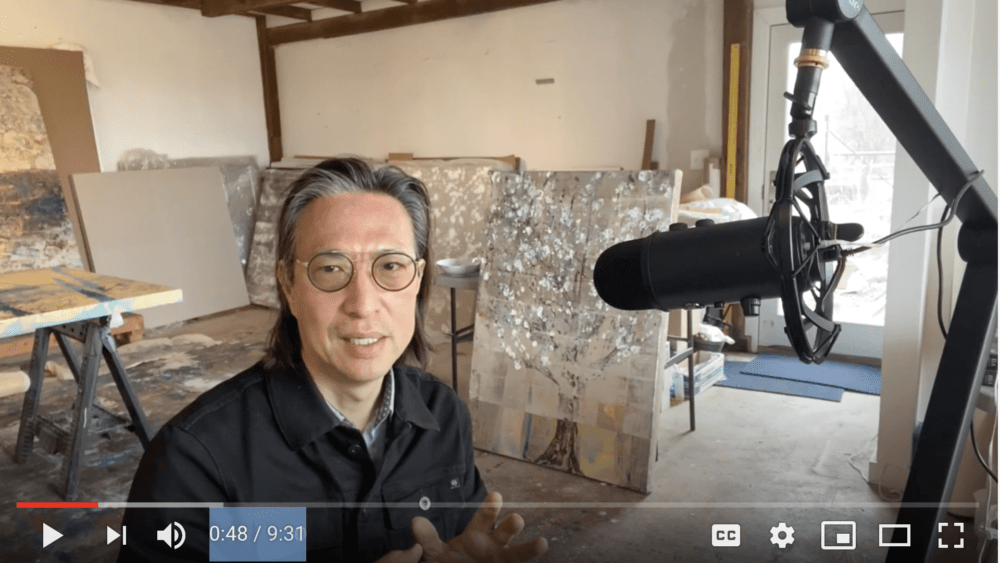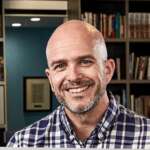Mako Fujimura tells Christian artists ‘this is a critical moment’
“If you’re an artist, musician, writer, poet, this is a critical moment,” world-renowned artist Mako Fujimura tells his online audience, looking serenely down the barrel of his iPhone camera.
The Japanese-American fine artist, who finds inspiration in his Christian faith, goes on: “Frangelico painted during the Black Plague. Shakespeare wrote during the Black Plague. And that period at the time gave birth to the Renaissance. What artists can do to internalise the pain and the fractures of the world and the dark realities of the world can articulate hope for us throughout future generations.”
Fujimura, like artists of all kinds, has turned to online platforms Instagram and YouTube to reach an audience during the social distancing restrictions of COVID-19. But unlike many, this world renowned fine artist is not looking for a digital version that can replace the crowd of a cancelled concert.
Instead, Fujimura has released a series of video daily “almost live” videos broadcast via YouTube from his studio designed to encourage other Christian artists to fulfil their God-given calling to create during this difficult period.
“Artists are kind of creating distance from society all the time, so when I came into the studio this morning, I was reminded the rhythm of what I do – and the generativity of what I do – may be somewhat helpful for those of you who may not be artists and who may not think of self-distancing as a blessing,” he said in the first video referencing the coronavirus, posted on March 22 from his studio at Princeton, New Jersey.
“It’s something that can cultivate something deeper within us to pray or reflect on our journeys. To appreciate the things that are around us, people that we love and nature that is all about us. Let’s not forget to enjoy what is given to us, as well as face the challenges and care and pray for those who are in need. Both beauty and mercy is necessary today more than ever.”
Slow art and spiritual reflection
Fujimura’s art has been featured widely in galleries and museums around the world, and is collected by notable collections including the Museum of Contemporary Art in Tokyo, the Huntington Library as well as Tikotin Museum of Japanese Art in Israel.
His process-driven, refractive “slow art” runs counter to contemporary society’s hectic pace, leading New York Times writer David Brooks to describe Fujimura’s work as “a small rebellion against the quickening of time”.
“Probably like you, I’ve felt a great need to take a break from this pace every once in a while and step into a slower dimension of time,” Brooks wrote. “Mako’s paintings are very good for these moments… gorgeous works of abstract expressionism, using a Japanese style called Nihonga.”
“He grinds colored minerals like malachite and azurite into fine particles and then layers them on paper. Each layer takes time to dry, and Mako may use 60 layers in a single work. Nihonga is slow to make and slow to see. Mako once advised me to stare at one of his paintings for 10 to 12 minutes. I thought it would be boring, but it was astonishing. As I stood still in front of it, my eyes adjusted to the work. What had seemed like a plain blue field now looked like a galaxy of colour.”
This slow process is spiritually rewarding for Fujimura. For example, he explains how layering oyster shell gofun powder (a white pigment made from ground and refined oyster shells) with water-based glue, onto specialty Japanese paper, and then watching it dry casts new light on the concept of God washing sins “whiter than snow” (found in Psalm 51:7).
“King David says ‘Cleanse me, O Lord, and as I am cleansed I shall be whiter than snow.’ So there’s both forgiveness of the creator God for our transgressions, but also there’s healing involved. Healing that is given to us by grace, but it is whiter than snow. I love that because that reminds me of this material. When you look at the surface of this painting, it is literally whiter than snow. It is opaque and transparent and it is luminous. It glows with light.
“To me that’s a sacred symbol of God’s forgiveness and healing that is being poured out. So, as an artist, I am layering and layering, and it’s almost like magic ink. You layer and you can’t see anything and then later, as it dried, it reveals itself. And I am literally watching my paintings dry.
“But that process is really healing to me. And I’m often sitting, seeing the magic that happens on the surface of my paintings, and it turns my heart into a place of reflection and prayer”.”
The artist’s responsibility
Fujimura says he is “honoured” to be an artist during this time of coronavirus, but he balances it with a sense of responsibility to use his art to the benefit of all society – a responsibility he has taken seriously for many years. It is in the artist’s response to the times, he explains, “what we create, rather than just consume… what we give rather than what we take” – that is is “counted and amplified in culture at large”.
For Fujimura, this sense of responsibility led him to serve as a US Presidential appointee to the National Council on the Arts from 2003-2009, as an international advocate for the arts, speaking with decision makers and advising governmental policies on the arts.
He has also written numerous books, received several awards, and delivered countless stirring speeches (for example, his Judson University Commencement Address 2019, entitled Kintsugi Generation that lays out his cultural vision for the next generation).
“So as I think about my layers and, as I hope to create enduring work that brings healing into the world, I am inviting you to journey with me,” he tells artists watching his video.
“And I want to encourage you today to think about generative living in the restrictions we are facing. This is a time for creative imagination to be given wings. This is a time when we share the deepest realm of our beings with each other.”
And where should they begin? Fujimura suggests simply paying attention to nature is a good place to start.
“Opportunities come to us through nature and as we steward the gifts of nature into the layers of creativity and imagination and art, something happens in that process where I believe we are not just fixing what is on hand.”
But if any aspiring artist may be tempted to reject the need for science in their pursuit of art, Fujimura is clear that both are needed.
“We pray for researchers and scientists and doctors who are trying to come up with a vaccination and prevent more deaths from happening. We pray for nurses and these courageous everyday heroes that are facing the front lines of the war against this virus and risking their own lives so they can care for patients –sometimes volunteering.
“And we are amazed what human beings can do to give mercy at such a time as this. But also it’s important that we need beauty to be created out of this time.”
https://youtu.be/_3U8J_MJQVw




